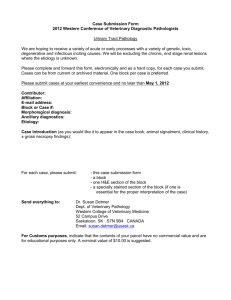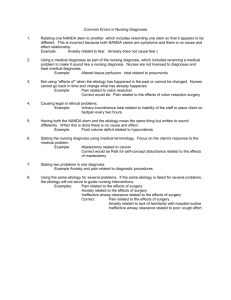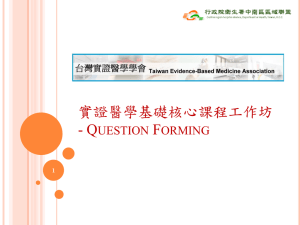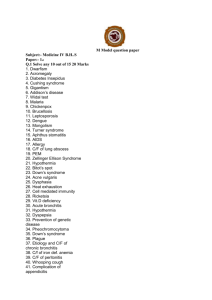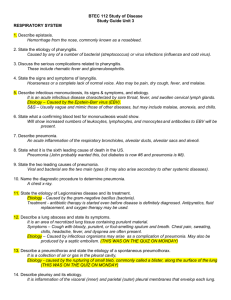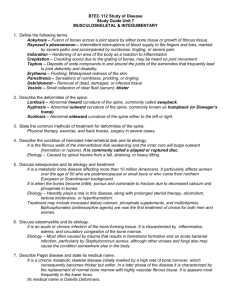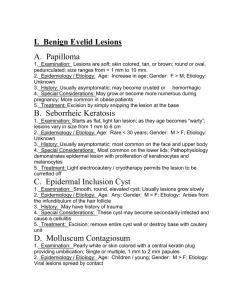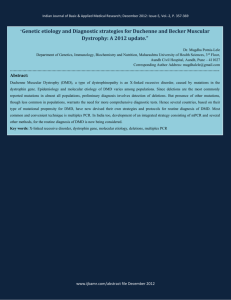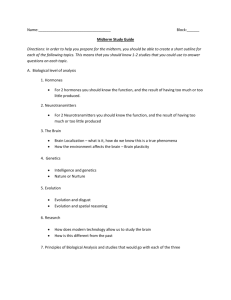Cradle to Grave Document - Missouri Dental Hygienists` Association
advertisement
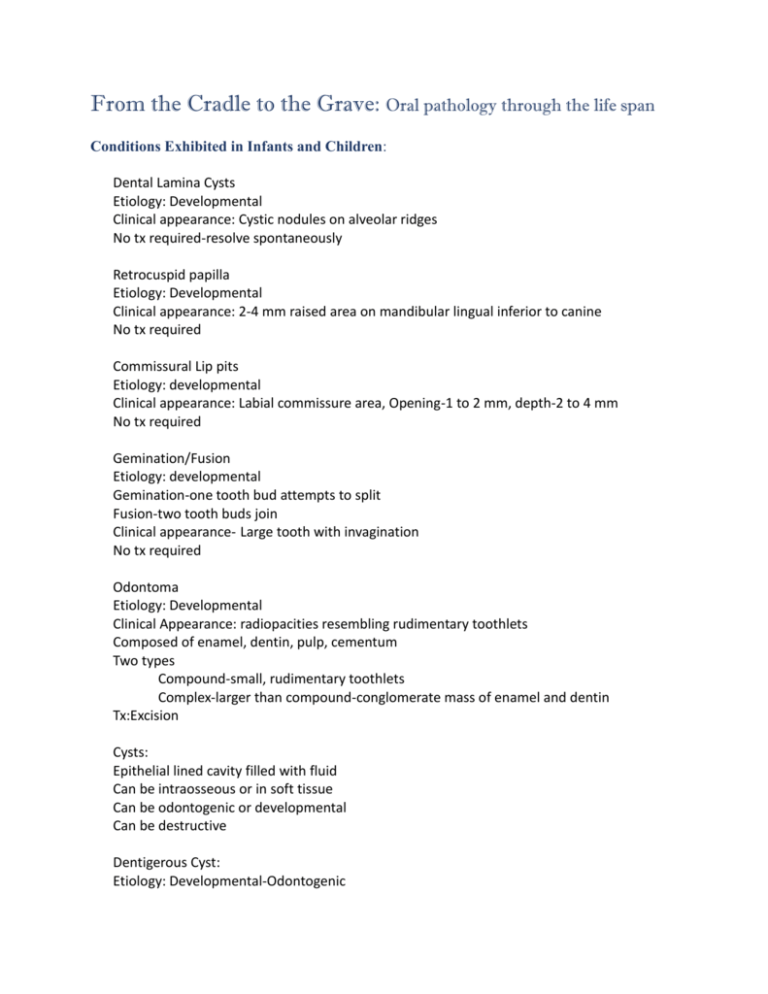
From the Cradle to the Grave: Oral pathology through the life span Conditions Exhibited in Infants and Children: Dental Lamina Cysts Etiology: Developmental Clinical appearance: Cystic nodules on alveolar ridges No tx required-resolve spontaneously Retrocuspid papilla Etiology: Developmental Clinical appearance: 2-4 mm raised area on mandibular lingual inferior to canine No tx required Commissural Lip pits Etiology: developmental Clinical appearance: Labial commissure area, Opening-1 to 2 mm, depth-2 to 4 mm No tx required Gemination/Fusion Etiology: developmental Gemination-one tooth bud attempts to split Fusion-two tooth buds join Clinical appearance- Large tooth with invagination No tx required Odontoma Etiology: Developmental Clinical Appearance: radiopacities resembling rudimentary toothlets Composed of enamel, dentin, pulp, cementum Two types Compound-small, rudimentary toothlets Complex-larger than compound-conglomerate mass of enamel and dentin Tx:Excision Cysts: Epithelial lined cavity filled with fluid Can be intraosseous or in soft tissue Can be odontogenic or developmental Can be destructive Dentigerous Cyst: Etiology: Developmental-Odontogenic Clinical Appearance: Surrounds the crown of an unerupted tooth (attached at CEJ) radiographically Tx -excision Eruption Cyst Etiology: Developmental Soft tissue variant of dentigerous Clinical Appearance: Bluish gray raised area No Tx required Hemangioma Etiology: Developmental Vascular anomaly Becomes apparent in childhood Clinical Appearance: Raised or flat blue lesion variable size Tx: Excision, may resolve spontaneously Ectodermal Dysplasia Etiology: hereditary disease of ectoderm, Group of 150+ genetic disorders hypohidrotic form most common, affects hair, skin, teeth, nails Clinical Appearance: dry sparse hair, dry skin, missing and developmentally deficient teeth, dystrophic nails Only fully expressed in males-females are carriers Tx-Prosthetic therapy Tricho-dento-osseous Syndrome Etiology: Hereditary Rare form of ectodermal dysplasia Affects hair (tricho), teeth (dento) and bone (osseous) Tx-manage dental defects Dental Manifestations Most common: Enamel Hypoplasia Taurodontism Osteogenesis Imperfecta with Opalescent teeth Etiology: Hereditary bone disease Fragile bones, fracture easily If associated with Opalescent teeth: Clinical Appearance: Bluish/brown discoloration with translucency, attrition, bulbous crowns, obliterated root canals Tx: Restorative Hand Foot and Mouth Disease Etiology: Coxsackievirus Seen in mini epidemics-children Clinical Appearance: Flu like symptoms-fever, sore throat, malaise Red macules with central vesicles-heal without crusting Intraorally-multiple vesicles that rupture-ulcers, 2-4 mm in diameter Tx: symptomatic Herpangina Etiology: Coxsackievirus (not associated with herpes as name implies) Clinical Appearance: Symptoms similar to HFM. Oral lesions similar to HFM, but posterior soft palate area-rarely anterior to this. Tx: symptomatic Multifocal Epithelial Hyperplasia (Heck’s Disease) Etiology: Human papilloma virus, types 13 and 32 Seen mostly in children and teenagers of ethnic populations Clinical Appearance: Normal color of surrounding tissue, clustered small soft rounded papules on labial, buccal, lingual mucosa No tx required Conditions Exhibited in Adolescents and Young Adults Adenomatoid Odontogenic Tumor Etiology: Unknown-Epithelial Odontogenic tumor with gland like structures Young age group Clinical Appearance: Anterior jaws, often assoc with impacted tooth radiographically Tx: Excision Conditions Manifesting Intraoral Pigmentation Racial pigmentation Drug therapy Metal impregnation Oral melanotic macule Smoker’s melanosis Systemmic Diseases Peutz-Jegher’s Syndrome Addison’s Disease Albright’s Syndrome Gardner’s syndrome Kaposi’s Sarcoma Oral Melanoma Peutz-Jegher’s Syndrome Etiology: hereditary- Intestinal polyposis Clinical Appearance: Perioral and intraoral pigmentation, pigmentation on hands and feet Gastrointestinal Adenocarcinoma or tumors of other organs Tx: Monitor polyps Addison’s Disease Etiology: Autoimmune, infections, tumors Insufficiency of the adrenal cortex Clinical Appearance: Bronzing of the skin and oral pigmentation Tx: corticosteroid replacement therapy Hereditary Hemorrhagic Telangiectasia (HHT) Etiology: Hereditary disorder – Offspring 50% chance of having the disease Also called Rendu-Osler-Weber Syndrome Highly variable – even among family members Only 10% are diagnosed Clinical Appearance: Telangiectasias-skin and mucous membranes Intraoral-telangiectasias on tongue, labial/buccal mucosa, palate, gingiva Nosebleeds in 90% arteriovenous malformations (AVMs)-lungs, brain, GI tract (iron deficiency anemia), liver Tx-Embolization of AVM’s, close follow-up, premedicate patients with AVM’s Pyogenic Granuloma Etiology: exuberant tissue response to local irritation or trauma Clinical Appearance: Red lesions, most common in interdental papilla region Granulation tissue-Endothelial cells, very vascular Tx: Excision Erosion/Bulemia Etiology: chemical Clinical Appearance: “moth eaten” loss of tooth structure from frequent purging May have enlarged salivary glands Tx: therapy for eating disorder, restorations Conditions exhibited in Adults Oral Cancer 90% are squamous cell carcinomas Most common area-lateral/ventral tongue, floor of mouth Risk factors(Etiology???) Tobacco (Smoked and smokeless) Alcohol (synergistic effect of the two) History of infections (HPV, EBV, HIV, Candida) Chronic irritation Immunosuppression Actinic Radiation (lip) Clinical Appearance: Types of lesions White patch-Leukoplakia Red patch-erythroplakia Red and white patch Ulcer Nodule *It can look very innocuous!!!!!! Snuff dipper’s lesion-wrinkled, white lesions Tx: If no dysplasia, remove cause and lesion will resolve Carcinoma In Situ: “Cancer in place” Tx: Excision Oral cancer Tx-Combination of excision, radiation, chemotherapy Human Papilloma Virus More than 100 subtypes, several oral manifestations in epithelial tissue Papilloma, Verucca Vulgaris, Multifocal Epithelial Hyperplasia Subtypes noted for Oral Cancer, primarily 16, but also 6,7,33,35,59 Papilloma Etiology: Human papilloma virus, primarily HPV 6 and 11 Any age – most in 30-50 Clinical Appearance: Exophytic, cauliflower like lesion, may have surface keratinization Tx-Surgical excision Verucca Vulgaris Etiology: Human papilloma virus 2,4,6, & 40 Clinical Appearance: Exophytic, cauliflower like lesion, found most in children (hands), most common on skin, rarely intraoral Vermillion border, labial mucosa, anterior tongue Tx-Surgical excision Multifocal Epithelial Hyperplasia-described earlier Condyloma Acuminatum Etiology-HPV, 2,6,11,53,54, sexually transmitted Clinical Appearance: Exophytic, cauliflower like lesion on oral mucosa or genitalia TX-surgical excision HIV/AIDS Etiology-Human Immunodeficiency virus, targets the CD4+ helper T lymphocyte Transmitted by sexual contact, parenteral exposure to blood, mother to fetus Acquired immunodeficiency syndrome-opportunistic infections as a result of immunosuppression Tx: Extended survival with highly active anti-retroviral therapy (HAART), no cure HIV Related Oral Lesions (HIV-ROL), 30% reduction of HIV-ROL with HAART Condyloma acuminatum, Oral candidiasis, Hairy leukoplakia, Kaposi sarcoma Detection of oral manifestations critical in unaware individual Oral Candidiasis Etiology: Candida albicans Clinical Appearance: erythematous-diffuse redness, acute pseudomembranous-white plaques which can be wiped off leaving a red base Tx: antifungals Oral Hairy Leukoplakia Etiology: Epstein Barr virus (EBV) Clinical Appearance: white corrugated plaques, lateral border of tongue Tx: antivirals Kaposi’s sarcoma Etiology: strongly associated with human herpesvirus type 8 Clinical Appearance: asymptomatic red macule, red/purple plaque, lobulated violet nodules that can ulcerate and cause pain Tx: radiation, injection of chemotherapeutics or sclerosing agents Irritation fibroma (focal fibrous hyperplasia) Etiology: Chronic irritation-the most common hyperplastic lesion of the oral cavity, fibrous connective tissue Clinical Appearance: Most commonly seen on gingiva, buccal mucosa, tongue. Smooth round sessile nodule Tx-Surgical excision Giant cell fibroma-variant of irritation fibroma Conditions Exhibited in Older Adults Candidiasis (moniliasis)-several forms, Etiology: candida albicans (fungal infection) Atrophic Acute (erythematous) – typically result of antibiotic therapy Chronic (denture stomatitis)Pseudomembranous (thrush) Chronic hyperplastic Angular cheiltiis Chronic Atrophic Candidiasis Clinical Appearance: Common beneath dentures, partials, flippers, usually asymptomatic, red area oftentimes in outline of appliance Tx-antifungal Medications (nystatin, clotrimazole) Acute Pseudomembranous Candidiasis (thrush) Clinical Appearance: White areas that can be wiped off with gauze and gentle pressure Tx-antifungal Medications (nystatin, clotrimazole) Median Rhomboid Glossitis Also called central papillary atrophy,Long term candida albicans infection, Usually asymptomatic Clinical Appearance: red, oval area on dorsum of tongue, anterior to circumvallate papillae Tx - antifungal Inflammatory Papillary Hyperplasia Etiology: Chronic irritation from ill fitting denture/appliance Clinical Appearance: Red papules in palatal area, asymptomatic, may be secondarily infected with candida albicans Tx-Refit denture/appliance, antifungal for candida Epulis Fissuratum Etiology-chronic trauma to oral mucous membranes Forms around the flanges of an ill-fitting denture Inflammatory fibrous hyperplasia, denture induced fibrous hyperplasia Clinical Appearance: Tumor-like hyperplasia of fibrous connective tissue Can be firm and fibrous, same color as surrounding tissue or erythematous and ulcerated Tx: excise redundant tissue, reline or remake denture Gingival Hyperplasia Etiology: multiple Exaggerated response to local factors, hormonal changes, drugs, hereditary, systemic disease: leukemia Tx: Remove/adjust cause Comprehensive home care program, gingivoplasty/gingivectomy Lichen Planus Etiology: Immune mediated Relatively common skin disease with oral manifestations, middle aged adults Several forms – reticular and erosive most common Clinical Appearance: Characteristic white lesion – Wickham’s striae on buccal mucosa (reticular) and erosive areas on gingiva (erosive) Tx: Corticosteroids Sjogren (Sicca) Syndrome Etiology: Autoimmune Complex multifactorial disease Two types-primary and secondary Primary affects the salivary and lacrimal glands Clinical Appearance: Enlarged Salivary glands, xerostomia Secondary Sjogren Syndrome 90% of cases women Rheumatoid arthritis most common assoc disease Can affect other body tissues-dry skin, nasal and vaginal mucosa Fatigue, depression, raynaud’s phenomenon, is chronic, risk of malignant transformation to lymphoma TX: Symptomatic Artificial tears and saliva Immaculate oral hygiene Dietary modification Fluoride therapy Pilocarpine Anemia/Vitamin Deficiencies Etiology: lack of iron, vitamins Clinical Appearance: papillary atrophy on tongue, aphthous like ulcerations Tx: Determine cause, iron/vitamin therapy Systemic Conditions manifesting aphthous like ulcerations: Gastrointestinal disorders Nutritional deficiencies Cyclic Neutropenia Celiac Disease Behcet Syndrome Sherri M Lukes, RDH, MS, FAADH President, Illinois Dental Hygienists’ Association Associate Professor Emerita Southern Illinois University Carbondale 680 Wing Hill Road Cobden, IL 62920 618-521-3392 smlukes@siu.edu

